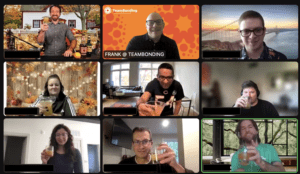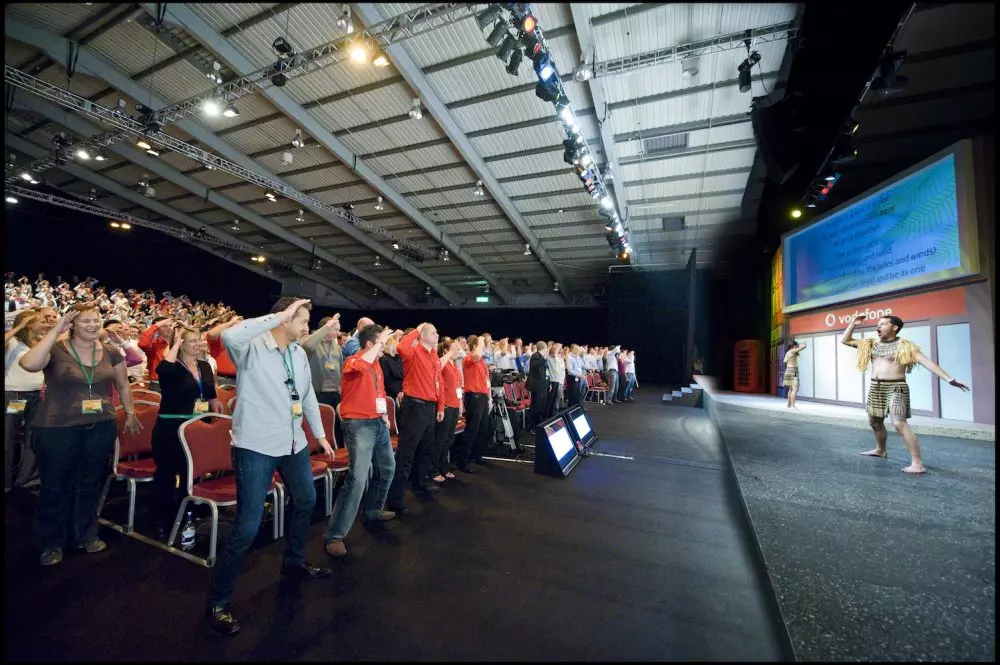When was the last time you engaged in some fun team building games with your colleagues? If you’re a leader, you likely know how powerful these tools can be for building your team and encouraging bonds between members.
There is a difference between team bonding vs. team building, but both types of events have the potential to improve communication, productivity, and a wide range of other skills.
In this article, we’ll explore some of the best team building and bonding exercises for teams to help you find the best choices for your crew. But first, we’ll look at the difference between team bonding vs. team building to clear things up.
Team Bonding vs. Team Building: What’s the Difference?
Before we dive into all our most fun team building games, let’s clear up these two terms. Team bonding isn’t just another name for team building—there are two different meanings:
- Team bonding focuses on strengthening personal relationships and trust between team members through shared experiences and social activities.
- Team building involves structured exercises and activities designed to improve work performance, collaboration, and other skills as a unified group.
So, one focuses on team bonds while the other focuses on team skills. But well-designed team-building exercises do both! Here at TeamBonding, we believe in the power of play and creativity, and we’ve spent over 25 years perfecting our programs.
Each of our events is designed to strengthen team bonds and build group skills. So you don’t have to pick between team building or team bonding—you can do both!
Top 12+ Fun Team Building Games: Best Picks for Every Occasion
Games to build team skills and strengthen bonds between colleagues come in all shapes and sizes. It’s easy to discount these games as something trivial or “just for fun,” but they’re so much more than that, and they offer so many benefits. They can:
- Boost Team Morale: These games and exercises can improve morale, which keeps everyone happy and productive.
- Improve Team Creativity: Games like these also get your team to think outside the box together, which offers huge benefits to your company.
- Better Teamwork: Playing together helps build relationships, which naturally boosts teamwork, collaboration, and communication.
There’s also a growing body of evidence showing that employees who play together as a team benefit in a number of ways. They tend to be more:
- Productive
- Creative
- Physically and mentally healthy
- Motivated
- Flexible
- Resilient
I could keep going with so many other benefits, but this isn’t the list you came here for! So, without further ado, here are my top picks for fun team building games that’ll build team bonds and team skills.
Fun Team Building Games for Outdoor Events
Want to get some fresh air with your team and let everyone enjoy time out of the office? Outdoor team building games are perfect for this, and they’re amazing for building bonds between colleagues.
Here are some of my favorites:
- Quickfire Soccer: This is a fast-paced, app-powered team building event that’ll help improve communication, time management, and problem-solving while everyone has fun together.
- High-Tech Scavenger Hunts: Tech meets teamwork in these adventure quests. They’re app-powered and designed to improve critical thinking, creativity, and problem-solving skills while your team explores a fun location.
- Outrageous Games: This one’s like field day for adults, except all the competitions are decidedly non-athletic. It’s designed to build team strength, facilitate communication, and help your team form connections.
These three events are just the beginning. We have so many more fun, outdoor team building games designed to get everyone soaking up the sunshine and having fun while they build skills and connect on a deeper level.
Fun Team Bonding Games for Remote & Hybrid Teams
With so many workplaces operating on a hybrid or remote model, outdoor events aren’t always an option for the whole team, and you don’t want to exclude anyone. The good news is that there are tons of fun team building games you can do virtually!
Here are some of my top picks for teams who want to have fun virtually:
- Virtual Happy Hour: This is a perfect opportunity to have some fun with your team while you’re apart, share some laughs, learn a new skill together, and build relationships. You’ll get to let loose and enjoy time with your coworkers, and we can customize it for any holiday or special event.
- Amazing Race Around the World: If you love scavenger hunts as much as I do, this is the one for you! Your team will compete in travel-based challenges while learning something new, having fun, growing, and connecting together.
- Jeopardy!® Game Show: This is an officially licensed game show event that can include questions about your company, products, and industry, while also mixing in lighthearted, funny trivia. It’s guaranteed fun and connection for all.
Getting virtual teams together for events and activities is so important. It’s all too easy to end up with a disconnected team when you’re working virtually, so it’s more important than ever to ensure everyone feels connected for cohesive teamwork.
Virtual team bonding games are the perfect way to bridge the gap, encourage colleagues to form work friendships, and build skills all at the same time. That’s why I’ve made sure our catalog features plenty of virtual team building games.
Fun Team Building Games to Leverage the Power of Play
Team building events that focus on the power of play are some of the best ways to get your team working together as a cohesive, collaborative, and productive unit. I’m not just making this up because I like to have fun, either!
Here are some of my favorite team building games to get your team members to tap into their inner children:
- Ice Cream Challenge Event: This one will have your team making ice cream and showing off their own delectable creations. It may seem like it’s just fun, but this event improves creativity and teamwork. Plus, everyone loves ice cream!
- Corporate CSI: Who doesn’t love a good mystery? This event is a great indoor event—it’s the ultimate crime-solving experience that’ll test your team’s deductive reasoning, communication, and critical thinking skills in a 3D virtual crime scene.
- Music Bus: In this event, you and your team will become a 90s cover band (or any era you’d like) and travel across your city, completing challenges and activities that lead to a climactic Battle of the Bands grand finale!
Almost every event in our catalog includes some element of laughter or play, but fun and engaging programs like these always get rave reviews from teams and leaders alike.
Fun Team Building Games To Strengthen Team Bonds
There are team building games for every company and group—it’s all about picking the right one for your crew. Trying out several team building events each year will also help you hone in on your employees’ favorite ways to spend their time.
When your team starts to talk about the events they’ve experienced together, that’s a sign that they’re truly strengthening their bonds. They’re developing shared memories that they connect over, which dramatically improves team collaboration.
Here are some more fun team building games to improve team bonds while building team skills:
- Laughter Yoga: Yes, I said laughter yoga! It’s designed to support both the mind and body with easy techniques like breathing, laughing, and eye contact to foster a healthy interdependence among your team. It’s great for de-stressing and preventing burnout.
- Quickfire Olympics: This event’s designed to build team spirit through puzzles, photo quests, and rapid-fire challenges, as your team races against the clock. It’s perfect for discovering hidden talents and fostering stronger connections.
- Employee Wellness Program: This is an outdoor program that’s designed to create a harmonious and thriving work environment. It helps build a company culture of continuous learning, positive actions, and collaboration.
The best recipe for an activity that gets your team to laugh, bond, and create memories together is an event designed for relationship building paired with fantastic people, locations, and planning.
Honorable Mentions
There are so many other events I’d like to include on this list! We have programs for every goal, team, location, and time frame, but there’s just not enough room to feature them all in one article.
So, before I go, here are some honorable mentions that I couldn’t help but share:
- Haka Team Building: A surefire way to shake things up; suitable for in-person and hybrid teams.
- Game of Drones: Great for employees who want to work on expanding their leadership and communication skills.
- Squad Game: Designed to amp up your staff’s competitive spirit while putting their resilience and focus to the test.
- Healthcare Heroes Scavenger Hunt: A fantastic way to get everyone moving, build long-lasting connections, help a worthwhile cause, and reap the benefits of CSR.
- Custom Company Event: If your team or company calls for a unique activity that’s not in our catalog, we have custom events for that very reason! We’ll make something from scratch that does exactly what you want it to (and then some).
You really have to try some of these to see why I love them so much—each one has been hand-crafted and refined to deliver reliable results and wow team members.
Plan an Unforgettable Event With TeamBonding
The fun team building games in the TeamBonding catalog are masterfully designed to build connections and skills while your team has the time of their lives. If you haven’t tried it, you’re missing out!
Trust me, once you see the difference these events make in your office, you’ll wonder why you didn’t do it sooner. You just can’t beat a happier, more productive team that’s better at collaboration, creativity, and problem-solving.
Are you ready to see the difference? Contact us today to get started. We’ll help you find the perfect event to help your team bond and grow together.

















